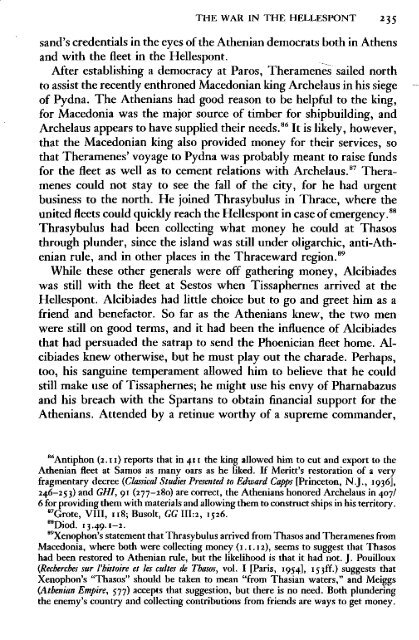The Fall of the Athenian Empire-(A New History of the Peloponnesian War) Donald Kagan - (1987)
MACEDONIA is GREECE and will always be GREECE- (if they are desperate to steal a name, Monkeydonkeys suits them just fine) ΚΑΤΩ Η ΣΥΓΚΥΒΕΡΝΗΣΗ ΤΩΝ ΠΡΟΔΟΤΩΝ!!! Strabo – “Geography” “There remain of Europe, first, Macedonia and the parts of Thrace that are contiguous to it and extend as far as Byzantium; secondly, Greece; and thirdly, the islands that are close by. Macedonia, of course, is a part of Greece, yet now, since I am following the nature and shape of the places geographically, I have decided to classify it apart from the rest of Greece and to join it with that part of Thrace which borders on it and extends as far as the mouth of the Euxine and the Propontis. Then, a little further on, Strabo mentions Cypsela and the Hebrus River, and also describes a sort of parallelogram in which the whole of Macedonia lies.” (Strab. 7.fragments.9) ΚΚΕ, ΚΝΕ, ΟΝΝΕΔ, ΑΓΟΡΑ,ΕΚΚΛΗΣΙΑ,ΝΕΑ,ΦΩΝΗ,ΦΕΚ,ΝΟΜΟΣ,LIFO,MACEDONIA, ALEXANDER, GREECE,IKEA
MACEDONIA is GREECE and will always be GREECE- (if they are desperate to steal a name, Monkeydonkeys suits them just fine)
ΚΑΤΩ Η ΣΥΓΚΥΒΕΡΝΗΣΗ ΤΩΝ ΠΡΟΔΟΤΩΝ!!!
Strabo – “Geography”
“There remain of Europe, first, Macedonia and the parts of Thrace that are contiguous to it and extend as far as Byzantium; secondly, Greece; and thirdly, the islands that are close by. Macedonia, of course, is a part of Greece, yet now, since I am following the nature and shape of the places geographically, I have decided to classify it apart from the rest of Greece and to join it with that part of Thrace which borders on it and extends as far as the mouth of the Euxine and the Propontis. Then, a little further on, Strabo mentions Cypsela and the Hebrus River, and also describes a sort of parallelogram in which the whole of Macedonia lies.”
(Strab. 7.fragments.9)
ΚΚΕ, ΚΝΕ, ΟΝΝΕΔ, ΑΓΟΡΑ,ΕΚΚΛΗΣΙΑ,ΝΕΑ,ΦΩΝΗ,ΦΕΚ,ΝΟΜΟΣ,LIFO,MACEDONIA, ALEXANDER, GREECE,IKEA
Create successful ePaper yourself
Turn your PDF publications into a flip-book with our unique Google optimized e-Paper software.
THE WAR IN THE HELLESPONT 237<br />
<strong>of</strong> spring, he had collected a fleet <strong>of</strong> eighty ships, and <strong>the</strong> A<strong>the</strong>nian<br />
commanders at Sestos were afraid lest he attack <strong>the</strong>ir own fleet <strong>of</strong><br />
forty." <strong>The</strong>y <strong>the</strong>refore left Sestos by night and sailed around <strong>the</strong><br />
Gallipoli peninsula to <strong>the</strong> port <strong>of</strong> Cardia on its nor<strong>the</strong>rn shore (see<br />
Map 5) ..' From <strong>the</strong>re <strong>the</strong>y sent ships to Thrasybulus and <strong>The</strong>ramenes<br />
in Thrace and Alcibiades at Lesbos with <strong>the</strong> message that <strong>the</strong>y should<br />
sail to Cardia as soon as possible. When <strong>the</strong> whole fleet was ga<strong>the</strong>red<br />
in one place, it numbered eighty-six, and "its generals were eager for<br />
a decisive battle. " 9 ' At Cardia <strong>the</strong>y heard that Mindarus had taken his<br />
entire force <strong>of</strong>f to Cyzicus on <strong>the</strong> sou<strong>the</strong>rn shore <strong>of</strong> <strong>the</strong> Propontis (see<br />
Map 5). Pharnabazus marched a large army to <strong>the</strong> same place; toge<strong>the</strong>r<br />
<strong>the</strong>y besieged <strong>the</strong> city and took it by storm. <strong>The</strong> A<strong>the</strong>nian generals<br />
decided to pursue <strong>the</strong> enemy to Cyzicus, force a battle <strong>the</strong>re, and<br />
recover <strong>the</strong> city. <strong>The</strong>y sailed around to Elaeus and waited until nightfall<br />
before undertaking <strong>the</strong> next leg <strong>of</strong> <strong>the</strong> journey. <strong>The</strong>y moved past<br />
Abydos under cover <strong>of</strong> darkness so that <strong>the</strong> enemy lookouts could not<br />
see <strong>the</strong>ir numbers and made <strong>the</strong>ir way to Parium and from <strong>the</strong>re to<br />
<strong>the</strong> island <strong>of</strong> Proconnesus, just to <strong>the</strong> northwest <strong>of</strong> <strong>the</strong> peninsula on<br />
which Cyzicus was located. 99<br />
that <strong>the</strong> best account is that <strong>of</strong> Diodorus, and my own narrative follows him, making<br />
use <strong>of</strong> <strong>the</strong> o<strong>the</strong>rs where appropriate.<br />
My version <strong>of</strong> <strong>the</strong> battle, along with <strong>the</strong> rest <strong>of</strong> <strong>the</strong> book, was in press when I<br />
discovered A. Andrewes' excellent article discussing <strong>the</strong> battles <strong>of</strong>Cyzicus and Notium<br />
(]HS CII [1982], 15-25). It is gratifying that <strong>the</strong> accoum <strong>of</strong>fered here is in substantial<br />
agreement with his.<br />
96<br />
Diodorus (•3·49-2) mentions A<strong>the</strong>nian "generals" at Sestos, and <strong>the</strong>re may well<br />
have been at least one o<strong>the</strong>r, unnamed, beside Chaereas. <strong>The</strong> figure <strong>of</strong> eighty ships is<br />
his (1].50.2); Xenophon (I.I.II) gives <strong>the</strong> number as sixty, which may be right, but<br />
I have preferred to accept <strong>the</strong> figure from <strong>the</strong> account that is in general superior.<br />
•nxenophon 1 .1.11 provides <strong>the</strong> detail <strong>of</strong> <strong>the</strong> departure at night.<br />
98 Such is a cautious rendering <strong>of</strong> Diad. 13 ·49· 3-4: 0'11'€006-vToJV 76JV O"TpaTfi'Y&-v 11'Epl.<br />
7&-v OAwv &wKw&uvEWo-a~ .. A more literal translation would be: "<strong>The</strong>y were eager to<br />
run every risk for <strong>the</strong> whole thing." We cannot know just what <strong>the</strong>y had in mind. <strong>The</strong><br />
"whole thing" could have been a final victory in <strong>the</strong> war; at <strong>the</strong> very least, it must have<br />
meant control <strong>of</strong> <strong>the</strong> Hellespont. Xenophon's account, here and elsewhere, places<br />
Alcibiades at <strong>the</strong> center <strong>of</strong> everything and ignores <strong>the</strong> o<strong>the</strong>r generals most implausibly.<br />
It is hard to avoid <strong>the</strong> conclusion that he is following a source close to Alcibiades,<br />
perhaps even Alcibiades himself. (See Bloedow, Alcibiades, 55, n. 325.) For <strong>the</strong> number<br />
<strong>of</strong> A<strong>the</strong>nian ships, see Xen. I.I.IJ.<br />
99<br />
Diod. IJ·49·J-6. Xenophon I.I.II-IJ tells <strong>the</strong> story as though Alcibiades was in<br />
full command and making all <strong>of</strong> <strong>the</strong> decisions. He alone goes overland from Cardia to<br />
Sestos and orders <strong>the</strong> fleet to sail around to meet him. From <strong>the</strong>re he is on <strong>the</strong> point<br />
<strong>of</strong> sailing <strong>of</strong>f to battle with only forty-six ships when <strong>The</strong>ramenes and Thrasybulus<br />
arrive with twenty ships each. Littman and Bloedow make clear how implausible that<br />
account is. Where Xenophon and Diodorus differ on details about this journey to

















